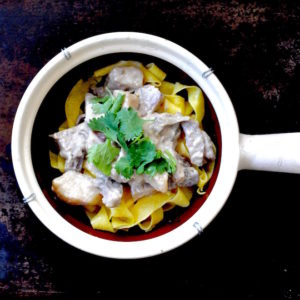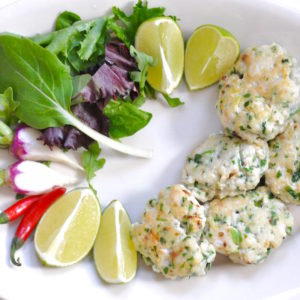Vietnamese Beef Salad
Shopping list:
port
coffee
scallions
sugar
green tea
okra
garlic
limes
tomatillos
black beans from bulk bin
lemongrass!!!
A few days ago I found myself staring at my shopping list, bemused. Okra? Tomatillos? Port? Lemongrass? When did I become a person urgently in need of lemongrass? Not so long ago I was a person unable to identify lemongrass at fifty paces, much less tomatillos, okra, or port.

Lemongrass, should you be unfamiliar with it, is indeed a grass, commonly utilized in Southeast Asian cooking to excellent effect. It also smells heavenly–well, more accurately, it smells lemony. Hence its name. Should you patronize Asian eateries, likely you’ve eaten lemongrass, perhaps without realizing it. For years I was unable to identify the ineffably exquisite flavoring that made Thai and Vietnamese dishes so good.Then, I can’t remember how or why, I blundered into buying lemongrass. Now I am never knowingly without a supply; hence the many exclamation marks on my shopping list.
Those of you unable to procure lemongrass have doubtless been told ginger makes a fine substitute. Many are the cookbooks promulgating this unfortunate falsehood. Alas, ginger no more replaces lemongrass than button mushrooms step in for truffles. Yet those you of living outside lemongrass proximity can hardly hop a plane. So do what you must on the quest for delicious food. For are we not striving for a better life? Raising a certain finger to those who would prefer us meek, quiet, and submissive?
Let us eat Vietnamese Beef Salad.

According to Naomi Duguid and Jeffrey Alford’s Hot Sour Salty Sweet, beef is not widely eaten in Vietnam, as there aren’t many cows. What beef is consumed comes mostly from water buffalos, and is considered a luxury. A pound of beef is expected to feed 4-6, not 2-3, as it does here. This dish, grilled lemongrass beef, is called thit bo nuong.
The idea is to marinate thinly sliced, fatless beef in a lemongrass/lime/fish sauce marinade. Depending on the recipe you’re looking at, these marinades can include brown sugar, garlic, hot pepper, shallot, rice vinegar, sesame oil, salt, and pepper. The beef can sit from 1-24 hours; obviously, the longer, the better. You then either grill or flash-cook the beef, sometimes at the table.
Traditionally, beef salads are served with raw vegetable platters piled with basil, cilantro, bean sprouts, thinly sliced carrot, cucumber, mint, chiles, lime wedges, and shredded lettuce. Each diner makes his/her (we really need a trans article here) meal by selecting from the array and rolling her/his/trans article choice in rice paper, lettuce leaf, or with a bite of rice.
When it comes cooking and serving Vietnamese Beef Salad Chez IK, we depart from classic Southeast Asian methods. After all, DIY meals and rare diseases really don’t mix.
Reversing order for a moment, let’s chat about serving. Our plates are collecting dust. Instead, we use pasta bowls, whose high sides prevent wayward food moments. Spoons are offered for the same reason, especially when rice is on the menu. Extra vegetables may be arranged on a platter and placed at table:

In terms of that vegetable platter, I tend to reach for whatever’s available. Radishes are available year round here. Yesterday at the market I spotted these Purple Ninja radishes. Are they not gorgeous?

There were these carrots, too.

Eventually I tore myself from photographing these beauties and got cooking. Which brings me to how authentic Southeast Asians prepare their marinades and how authentically tendonitic American women prepare theirs. The idea is to take shallots, lemongrass, and garlic and either pulverize them with a mortar and pestle or grind them in a food processor, adding lime and fish sauce. This fragrant paste is spread over the meat, and all is set to meld into a very moreish substance, as the English say, until cooking time.
If you are achey-armed and dishwasherless, neither pounding nor washing the many small pieces of your food processor may appeal. In this case, you might occasionally slice everything haphazardly, give it a rudimentary pounding, mix in fish sauce and lime, then set it n’ forget it. Happily, this sloppy method affords divine results. Granted, it will not earn you a spot in the 2017 Ten Speed Cookbook Pub list. Alas, life is harsh.

A couple notes about using lemongrass: You’ll tear off lots of outer dry, stalky stuff before finally reaching a very small amount of useful inner stalk. Mince this tiny bit. I like to toss the longer, near-tender pieces into the marinade. Then I compost them just before cooking.
In terms of the leftover garlic and shallot, most people don’t cook it. I like to add it to the wok as I go, but do whatever you wish. This isn’t a very liquid marinade; there won’t be lots left in the dish.

The dipping sauce I make here involves fish sauce and lime to taste. It’s hard to give a specific recipe–taste as you go, using a lettuce leaf. Some people like adding superfine or brown sugar. Others add a little mirin or rice wine vinegar (I am one of these). Still others slice a few scallions, hot red peppers, or garlic cloves. It’s best to pour small amounts of fish sauce and lime into a small dish. I do recommend Red Boat Fish Sauce. While a bit more money, you aren’t drinking it.

Finally, I’ve decided to stop giving preparation times in recipes. I mean, if I know how long something takes to cook, like a roast, I’ll certainly say so. But I have no idea what kind of cook you are, meaning any prep time I offer is just a guess. After struggling with this, I’ve noticed esteemed writers like Nigel Slater and Diana Henry don’t ever give prep times. So, hey. Neither am I.
This recipe is all work up front. None of it is complicated or difficult–it’s a little chopping. The cooking itself is literally moments.
Vietnamese Beef Salad
yield: 2-4 servings
1 pound fatless beef, very thinly sliced (top round or tri-tip are good choices)
For the marinade:
1 tablespoon fish sauce (Nam Pla)
1 shallot, peeled and thinly sliced
2-4 garlic cloves, peeled and crushed
Juice of 1 large lime or 2 small limes
2 stalks lemongrass, minced (substitute teaspoon minced ginger if you cannot get lemongrass. It will not taste the same. But it will be good.)
To cook the beef:
Peanut or canola oil, ideally high heat
For the vegetable platter: choose your favorites. These are just some ideas:
sliced carrots
sliced radishes, greens attached if fresh
thinly sliced cucumber, peeled or not
shredded lettuce
chile peppers
sprigs of cilantro, mint, parsley
quartered limes
For the dipping sauce:
juice of a lime
fish sauce
mirin or brown rice vinegar
a few slices of scallion
a few slices of hot pepper
a few slices of garlic
Make the marinade. In a food processor, mortar and pestle, or lazily by hand, chop the shallot, garlic, and lemongrass into a rubble. Add the lime and fish sauce.
Place meat in a rimmed dish or baker. Spread marinade over. I find this easiest with my hands, but use a spoon or spatula if you prefer. Cover with foil or plastic wrap and refrigerate 1-24 hours.
Remove meat from refrigerator 45 minutes before serving.
Make dipping sauce just before eating. In a small bowl, mix lime juice, fish sauce, brown rice vinegar or mirin to taste. Add hot pepper, scallion, and garlic if you wish.
Prepare vegetable platter by slicing vegetables of your choice and arranging them on platter or plates.
To cook the meat, heat a wok, cast iron, or heavy frying pan on high heat. Pour in enough peanut oil to coat the bottom. Sauté meat in batches: my wok can take two pieces at a time; don’t crowd the pan. These thin pieces take literally 30 seconds a side. Stay at the stove, turning each piece of meat quickly, removing them to a platter as they cook. If pan goes dry, carefully add a little water–it will sputter–or additional oil.
Serve with rice, noodles, or rice paper wrappers.
Leftovers keep in covered containers, refrigerated, up to 2 days.





